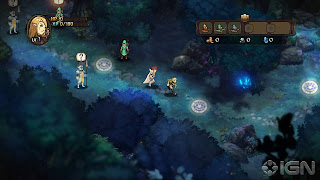PLATFORM: EXCLUSIVE ON PSP
GENRE: RPG
Final Fantasy IV: The Complete Collection isn't only a re-release of Final Fantasy IV as we already know it. It also includes all of the Wii-centric episodic releases of Final Fantasy IV: The After Years, as well as an all new game known as Final Fantasy IV: Interlude that ties the events of Final Fantasy IV and The After Years together.
If you're unfamiliar with Final Fantasy IV, let me catch you up. First released on the SNES back in 1991, Final Fantasy IV is a traditional console JRPG. It tells the story of a Black Knight named Cecil who, after committing heinous crimes on behalf of his king, attempts to right past wrongs. Along his journey, he meets a cast of characters that are amongst the most interesting characters in the entire Final Fantasy series. From the deceitful Dragoon Kain and the summoner Rydia to the ninja king Edge and the twin mages Porom and Palom, Final Fantasy IV's cast is among the strongest in RPG history. The fact that these characters end up on an unavoidable path to save the world simply makes them all the more likeable, even if each of them has flaws that are, at times, significant.
Final Fantasy IV plays much like many traditional RPGs of the time. Gamers will control a party of up to five characters. By visiting a variety of locales, from castles and dungeons to towns and cities, you'll be able to progress through the primary story of Final Fantasy IV, while occasionally branching off to complete some random side quests and other peripheral tasks. Many locations are associated to an overarching world map that players will often travel over. And combat in the game is triggered by random encounters. Once a random encounter has trapped your party, you'll have to fight through enemies using Final Fantasy IV's turn-based-but-not-quite system known as Active Time Battle. This system puts an impetus on actively paying attention to each fight, as opposed to a more straight forward turn-based affair ala the Dragon Quest series.
What makes this re-release of Final Fantasy IV all the stronger is the extra content that's included in the overall package. The After Years takes place nearly two decades after the events of Final Fantasy IV, and deals with Ceodore, the son of Cecil and the white mage Rosa. Its episodic approach means that you'll be playing scattered events using many characters from Final Fantasy IV, as well as a slew of new playable characters, both familiar and unknown. Final Fantasy IV: Interlude, on the other hand, takes place almost directly after Final Fantasy IV, and deals with the events leading up to Ceodore's birth. Both The After Years and Interlude otherwise play identically to Final Fantasy IV itself, using familiar locations and graphical and audio assets, though The After Years throws a few curveballs at gamers, including a combat system called Band and a strength and weakness system based on the phases of the moon. Interlude is short -- a mere three hours -- but The After Years will take you a much more significant amount of time to work through.





 But there’s just as much here for gamers who are unfamiliar with Final Fantasy IV. The main game is enough of a draw, but having all of this extra content will simply give you more bang for your buck. Just be sure to play sequentially if you’re new to Final Fantasy IV, or you’ll be completely lost. If you haven’t played Final Fantasy IV, are a fan of RPGs, and don’t find yourself utterly impressed with the game, I will be surprised.
But there’s just as much here for gamers who are unfamiliar with Final Fantasy IV. The main game is enough of a draw, but having all of this extra content will simply give you more bang for your buck. Just be sure to play sequentially if you’re new to Final Fantasy IV, or you’ll be completely lost. If you haven’t played Final Fantasy IV, are a fan of RPGs, and don’t find yourself utterly impressed with the game, I will be surprised.































